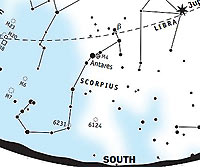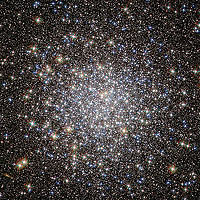July’s Cloudscapes |
||||
The fourth-century B.C. Greek dramatist Aristophanes said, “Clouds are the patron goddesses of idle fellows.” Wispy, ephemeral, scattered – these are the traits that make day dreamers and drifting clouds so interesting.
|
||||
| So Many Stars in Our Summer Sky By Ranger Scott Chandler |
||||
Southeastern Utah’s night skies are some of the nicest in the lower 48, yet with the coming of the summer solstice, they can be a little harder to stay up for here in July. I would argue that the nightly show of staying up that extra little bit is worth the small feeling of tiredness the next day.
At the southern end of the Milky Way (as we Moabites see it) sits a glorious hook of a constellation. While some constellations struggle to fit their namesake or are made of faint stars, this one is another showstopper of our summer nights. It is also perfect for our arid environment. Scorpio the Scorpion will dance across our southern horizon throughout the month. Scorpio’s hook like shape is perfect, a long curved tail swinging down from a prong of stars indicative of pincers. The red supergiant Antares lies in the heart of the constellation, so distinct from other stars in coloration that it is the easiest way to find the constellation.
Another type of star cluster sits near Scorpio and shows the differences of our galaxy’s structure. Looking just to the right of Antares, within the same view if using binoculars, sits a fuzzy blob of stars in a field of darkness. This star cluster is different. It is more circular, the stars less obvious to distinguish from one another. This is because these stars are far older, far fainter. While an open cluster, made in the spin of our galactic disk, will have a couple tens of bright young stars, a globular cluster was made when the galaxy was young, often as old as 11-13 billion years old and consisting of hundreds of thousands of dim red dwarf stars. These globular clusters sit independent of our galactic disk, hanging out in the bulge or “halo” of our galaxy, hinting that may be the original structure our Milky Way had. I imagine it would have been more aptly named the “Fuzzy Ball” back then… The few objects in and around Scorpio are but a few of the immense number of starry features of Moab’s summer night skies. To the naked eye there are many vibrant and sprawling constellations to trace across space and then many a feature that with some magnification turns out to be far more. The night skies of southeastern Utah generally have little light pollution flowing into them so stargazing here is some of the best in the country, and the multitude of public lands in the area make access easy. Rangers from Dead Horse Point State Park and Arches and Canyonlands National Parks will be having night sky programming through the month to celebrate this vibrant show. Remember that Dead Horse Point State Park closes to anyone not camping at 10:00pm; luckily, Canyonlands National Park is right next door and open further into the night. Check with the individual parks about night sky programming happening soon (deadhorsepoint.utah.gov for my park.) |
||||
| Dead Horse Point State Park is located 32 miles from Moab heading north on US 191 and west on SR 313. The park fee is $15 per vehicle and valid for three days. If you have questions about your visit, contact the park at 435-259-2614 or visit deadhorsepoint.utah.gov. |

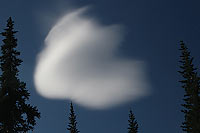
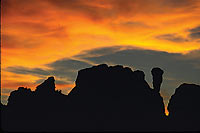 Howard’s presentation focused on the scientific naming or nomenclature of clouds. At this point in time, meteorology was in its infancy as a natural science. Howard knew from his years of observation that clouds came in many individual shapes, but there were only several basic forms. He named his three basic forms with Latin terms: cirrus (meaning tendril or hair), cumulus (meaning heap or pile), and stratus (meaning layer or sheet). Howard also observed that clouds were ephemeral and that their instability needed more definition. So, he devised 7 other names to represent intermediate or compound forms, such as cirrocumulus and cirrostratus named for wispy clouds that descended and transformed into a low-level sheet of clouds. His presentation literally opened up the skies to study and provided scientists and fledgling meteorologists a common language, a nomenclature of clouds.
Howard’s presentation focused on the scientific naming or nomenclature of clouds. At this point in time, meteorology was in its infancy as a natural science. Howard knew from his years of observation that clouds came in many individual shapes, but there were only several basic forms. He named his three basic forms with Latin terms: cirrus (meaning tendril or hair), cumulus (meaning heap or pile), and stratus (meaning layer or sheet). Howard also observed that clouds were ephemeral and that their instability needed more definition. So, he devised 7 other names to represent intermediate or compound forms, such as cirrocumulus and cirrostratus named for wispy clouds that descended and transformed into a low-level sheet of clouds. His presentation literally opened up the skies to study and provided scientists and fledgling meteorologists a common language, a nomenclature of clouds.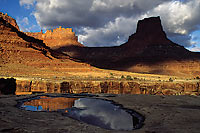 Like clouds themselves, Howard’s initial system of names has been refined and reshaped over the years. His observations also concluded that clouds were subjected to the same forces of gravity as anything on the planet: clouds would gradually descend but could be kept aloft by warm air rising off the ground.
Like clouds themselves, Howard’s initial system of names has been refined and reshaped over the years. His observations also concluded that clouds were subjected to the same forces of gravity as anything on the planet: clouds would gradually descend but could be kept aloft by warm air rising off the ground.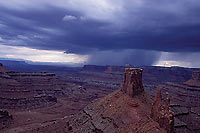 In Canyon Country, clouds often create a backdrop or highlight spectacular geologic feathers. A photograph of Delicate Arch with the snow-less La Sals in the background lacks the subtle punch compared to the same image with towering thunderheads capping the mountain peaks. Or maybe it is a series of roll clouds washing over sandstone fins in the Devils Garden provides creates an alluring connection between earth and sky.
In Canyon Country, clouds often create a backdrop or highlight spectacular geologic feathers. A photograph of Delicate Arch with the snow-less La Sals in the background lacks the subtle punch compared to the same image with towering thunderheads capping the mountain peaks. Or maybe it is a series of roll clouds washing over sandstone fins in the Devils Garden provides creates an alluring connection between earth and sky.